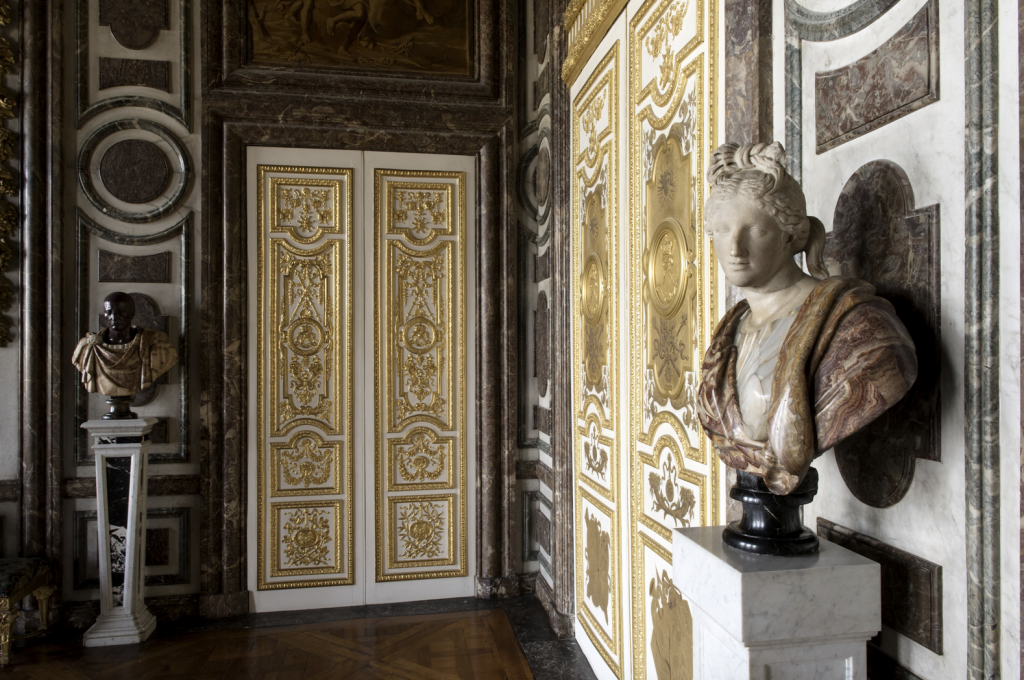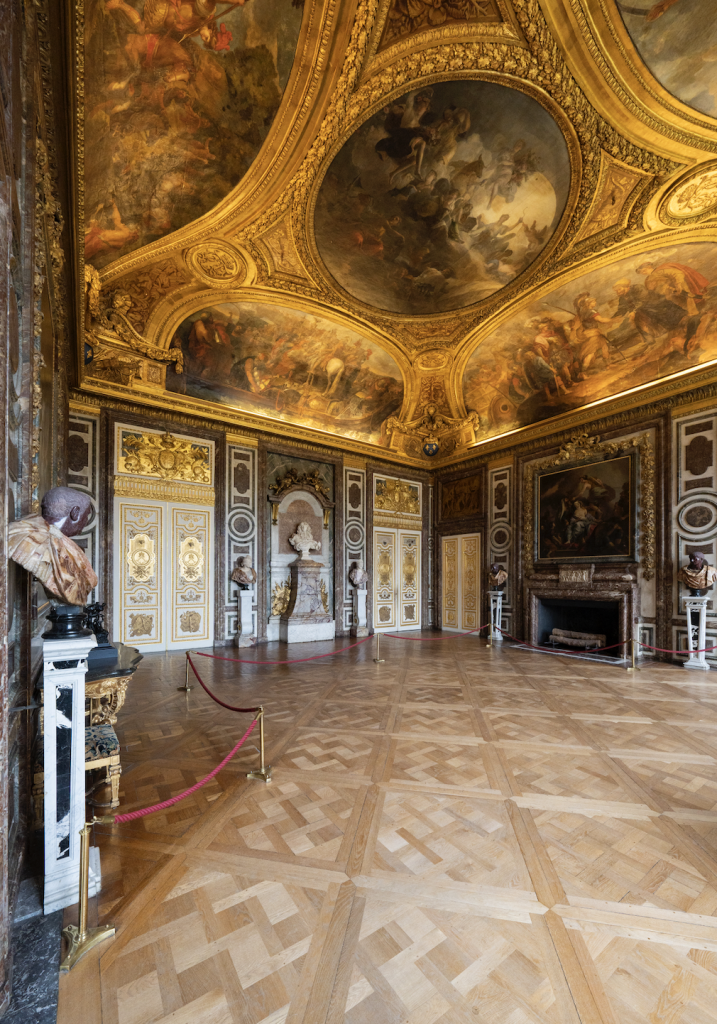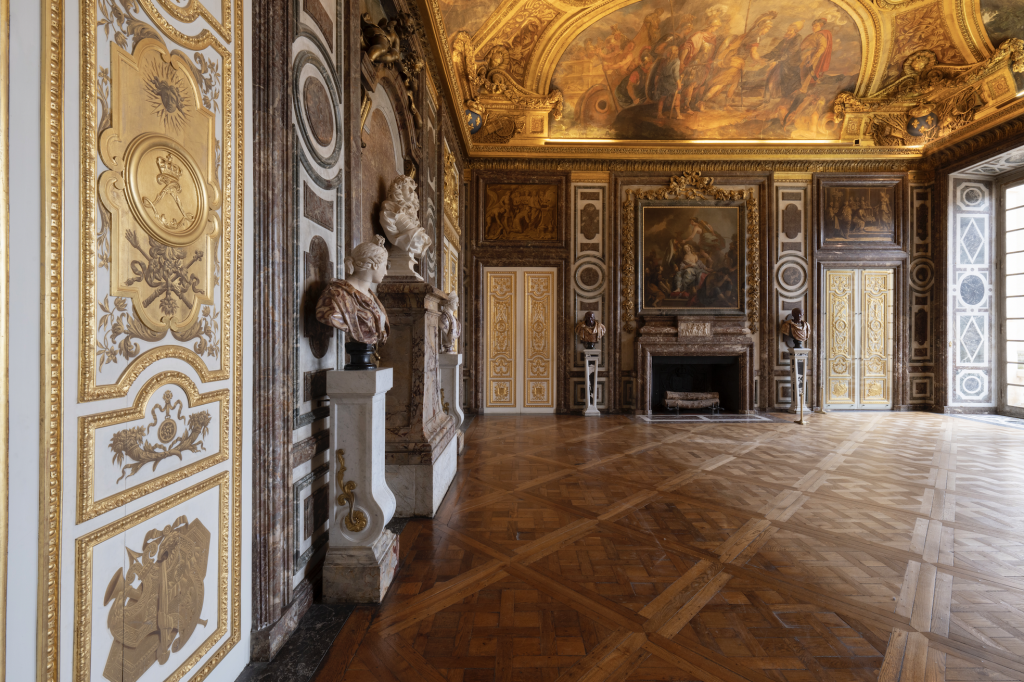Museums & Institutions
Versailles’s Legendary Salon de Diane Is Getting a Lavish Restoration
King Louis XIV used the chamber to show off his prowess at the billiards table.

King Louis XIV’s Versailles party room is getting the royal treatment. American Friends of Versailles aims to raise some €1.2 million (about $1.3 million) for the restoration of the Salon de Diane, which begins this month. Two years from now, the antechamber’s tired, cloudy ceiling paintings honoring the Roman goddess of the hunt will regain their divine glow—just in time for the 250th celebration of American independence, secured with help from France.
“It’s really important to continue strengthening ties between France and America,” Alicia Bryan, the impassioned new San Antonio, Texas–based president at American Friends of Versailles, told me over the phone. “Our collective mission should be to all come together to preserve our great histories.”

Ornate Italian-style detailing on the Salon de Diane. Photo © Thomas Garnier, courtesy of Palace of Versailles.
Of course, it’s not the first time Versailles has received restorations. Even this Salon—one of seven rooms in the King’s Greek deity-themed state apartment—was touched up in 1814 and 1955. Repainting efforts, however, obscured the artworks’ original hues. The varnish applied has grown opaque, and the ceiling artworks’ canvases are peeling from their surfaces, resulting in blisters and gaps. The painted plaster platbands are cracking, and the overdoor easel paintings haven’t really been touched.
“The work carried out in the early 19th century was more respectful,” Beatrice Sarrazin, curator at the Château de Versailles, said of the previous restorations over email. “But it’s normal for materials to age over time, and for restoration work to have to be repeated every 50 or 60 years.” Fortunately, the Salon’s standalone artworks, like Lorenzo Bernini ‘s 1665 bust of Louis XIV, remain stable.
Louis XIV started decorating this room in 1671. His royal family and court convened here frequently to let loose over liqueur and billiards, the monarch’s favorite game. In true Sun King style, two tiers of seats were installed for these evenings, so guests could bask in his prowess.
First Painter to the King Charles Le Brun designed the Salon, and employed three prominent painters to complete it—Gabriel Blanchard, Charles de La Fosse, and Claude Audran II. Le Brun offered Blanchard and De la Fosse artistic liberty, but instructed Audran the Younger to harmonize with his own work throughout Versailles.

A view of the Salon’s ceiling. Photo: Palace of Versailles.
Blanchard painted the ceiling’s tondo, a round central panel, which depicts Diana presiding over a hunt from her deer-drawn carriage, surrounded by children, animals, and maidens representing different times of day. De la Fosse and Audran the Younger split the surrounding four archivolts, the moulding that curves along the arches.
The north and east archivolts elaborate on Louis XIV’s interest in hunting, with De la Fosse’s Alexander the Great Hunting Lions and Audran’s Cyrus Hunting Wild Boar. The south and west archivolts honor advancements in trade made by the king’s administration, like Colbert’s founding of the East and West India Companies, also through two Greek tales—Jason Landing in Colchis by De la Fosse, and Caesar Sending a Roman Colony to Carthage by Audran.
Experts evaluated the room in 2019 and determined that both the paintings and their supports need attention. The east and south archivolts are the worst off. It’s too early to say how restorers will go about their work. But, said Sarrazin, “It is certain that we will recover some of the 17th-century original painting and, if necessary, retain the 19th-century restorations.”

The Salon de Diane, featuring a mantle painting by Blanchard. Courtesy Palace of Versailles.
Every restoration also offers an opportunity to understand the palace’s history. “For example, the restoration work carried out in 1814 and 1815 was the work of well-known artists whose style is clearly recognizable,” Sarrazin said. “Restoration is also an ideal time to learn more about the techniques used by the artists… what types of preparation did they use, did they proceed with hesitation?”
Typically the Salon plays a starring role on Versailles tours. Fortunately, guests will continue passing through during restorations, catching glimpses of restoration history in action.





